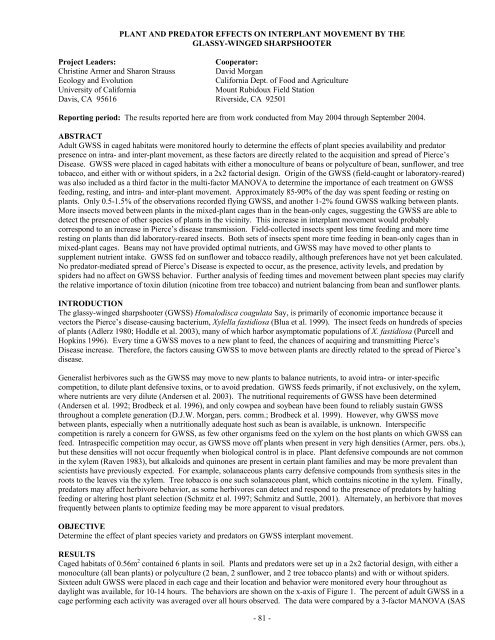Impact Of Host Plant Xylem Fluid On Xylella Fastidiosa Multiplication ...
Impact Of Host Plant Xylem Fluid On Xylella Fastidiosa Multiplication ...
Impact Of Host Plant Xylem Fluid On Xylella Fastidiosa Multiplication ...
Create successful ePaper yourself
Turn your PDF publications into a flip-book with our unique Google optimized e-Paper software.
PLANT AND PREDATOR EFFECTS ON INTERPLANT MOVEMENT BY THE<br />
GLASSY-WINGED SHARPSHOOTER<br />
Project Leaders:<br />
Christine Armer and Sharon Strauss<br />
Ecology and Evolution<br />
University of California<br />
Davis, CA 95616<br />
Cooperator:<br />
David Morgan<br />
California Dept. of Food and Agriculture<br />
Mount Rubidoux Field Station<br />
Riverside, CA 92501<br />
Reporting period: The results reported here are from work conducted from May 2004 through September 2004.<br />
ABSTRACT<br />
Adult GWSS in caged habitats were monitored hourly to determine the effects of plant species availability and predator<br />
presence on intra- and inter-plant movement, as these factors are directly related to the acquisition and spread of Pierce’s<br />
Disease. GWSS were placed in caged habitats with either a monoculture of beans or polyculture of bean, sunflower, and tree<br />
tobacco, and either with or without spiders, in a 2x2 factorial design. Origin of the GWSS (field-caught or laboratory-reared)<br />
was also included as a third factor in the multi-factor MANOVA to determine the importance of each treatment on GWSS<br />
feeding, resting, and intra- and inter-plant movement. Approximately 85-90% of the day was spent feeding or resting on<br />
plants. <strong>On</strong>ly 0.5-1.5% of the observations recorded flying GWSS, and another 1-2% found GWSS walking between plants.<br />
More insects moved between plants in the mixed-plant cages than in the bean-only cages, suggesting the GWSS are able to<br />
detect the presence of other species of plants in the vicinity. This increase in interplant movement would probably<br />
correspond to an increase in Pierce’s disease transmission. Field-collected insects spent less time feeding and more time<br />
resting on plants than did laboratory-reared insects. Both sets of insects spent more time feeding in bean-only cages than in<br />
mixed-plant cages. Beans may not have provided optimal nutrients, and GWSS may have moved to other plants to<br />
supplement nutrient intake. GWSS fed on sunflower and tobacco readily, although preferences have not yet been calculated.<br />
No predator-mediated spread of Pierce’s Disease is expected to occur, as the presence, activity levels, and predation by<br />
spiders had no affect on GWSS behavior. Further analysis of feeding times and movement between plant species may clarify<br />
the relative importance of toxin dilution (nicotine from tree tobacco) and nutrient balancing from bean and sunflower plants.<br />
INTRODUCTION<br />
The glassy-winged sharpshooter (GWSS) Homalodisca coagulata Say, is primarily of economic importance because it<br />
vectors the Pierce’s disease-causing bacterium, <strong>Xylella</strong> fastidiosa (Blua et al. 1999). The insect feeds on hundreds of species<br />
of plants (Adlerz 1980; Hoddle et al. 2003), many of which harbor asymptomatic populations of X. fastidiosa (Purcell and<br />
Hopkins 1996). Every time a GWSS moves to a new plant to feed, the chances of acquiring and transmitting Pierce’s<br />
Disease increase. Therefore, the factors causing GWSS to move between plants are directly related to the spread of Pierce’s<br />
disease.<br />
Generalist herbivores such as the GWSS may move to new plants to balance nutrients, to avoid intra- or inter-specific<br />
competition, to dilute plant defensive toxins, or to avoid predation. GWSS feeds primarily, if not exclusively, on the xylem,<br />
where nutrients are very dilute (Andersen et al. 2003). The nutritional requirements of GWSS have been determined<br />
(Andersen et al. 1992; Brodbeck et al. 1996), and only cowpea and soybean have been found to reliably sustain GWSS<br />
throughout a complete generation (D.J.W. Morgan, pers. comm.; Brodbeck et al. 1999). However, why GWSS move<br />
between plants, especially when a nutritionally adequate host such as bean is available, is unknown. Interspecific<br />
competition is rarely a concern for GWSS, as few other organisms feed on the xylem on the host plants on which GWSS can<br />
feed. Intraspecific competition may occur, as GWSS move off plants when present in very high densities (Armer, pers. obs.),<br />
but these densities will not occur frequently when biological control is in place. <strong>Plant</strong> defensive compounds are not common<br />
in the xylem (Raven 1983), but alkaloids and quinones are present in certain plant families and may be more prevalent than<br />
scientists have previously expected. For example, solanaceous plants carry defensive compounds from synthesis sites in the<br />
roots to the leaves via the xylem. Tree tobacco is one such solanaceous plant, which contains nicotine in the xylem. Finally,<br />
predators may affect herbivore behavior, as some herbivores can detect and respond to the presence of predators by halting<br />
feeding or altering host plant selection (Schmitz et al. 1997; Schmitz and Suttle, 2001). Alternately, an herbivore that moves<br />
frequently between plants to optimize feeding may be more apparent to visual predators.<br />
OBJECTIVE<br />
Determine the effect of plant species variety and predators on GWSS interplant movement.<br />
RESULTS<br />
Caged habitats of 0.56m 2 contained 6 plants in soil. <strong>Plant</strong>s and predators were set up in a 2x2 factorial design, with either a<br />
monoculture (all bean plants) or polyculture (2 bean, 2 sunflower, and 2 tree tobacco plants) and with or without spiders.<br />
Sixteen adult GWSS were placed in each cage and their location and behavior were monitored every hour throughout as<br />
daylight was available, for 10-14 hours. The behaviors are shown on the x-axis of Figure 1. The percent of adult GWSS in a<br />
cage performing each activity was averaged over all hours observed. The data were compared by a 3-factor MANOVA (SAS<br />
- 81 -











